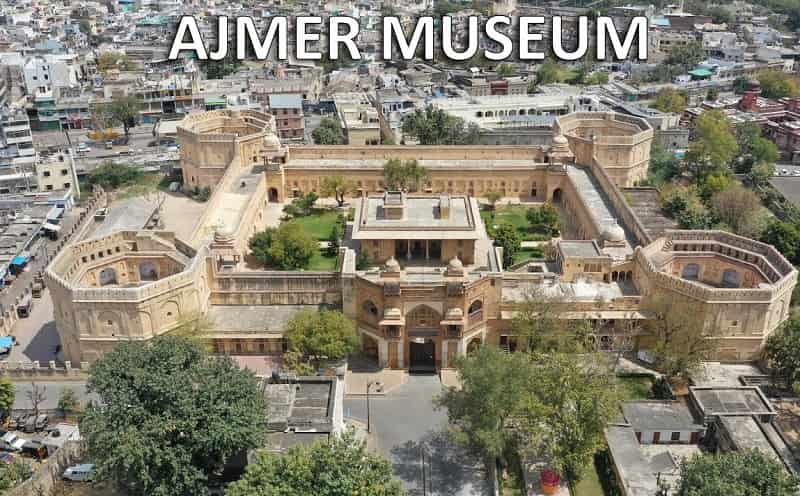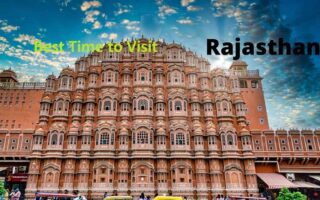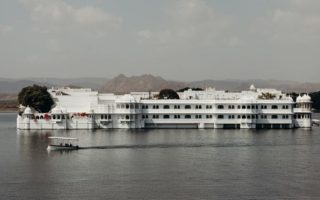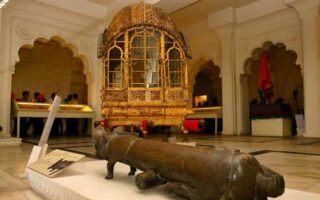- Location: Ajmer, Rajasthan
- Built in: 1908 AD
- Timings: 10.00 am to 4.30 pm
- Entry Fees: Free entry every Mondays, information about the other day’s fees is not specific.
- Attractions: Epigraphs, Prehistoric Antiques and Sculptures.
How to Reach Here: Sanganer airport is at a distance of 132km from Ajmer. Ajmer’s railway station is located near the famous Dargah of Ajmer Sheriff. Good network of roads connects Ajmer to places like Jaipur, Jodhpur, Udaipur, Bharatpur, Delhi and Jaisalmer.

Ajmer Government Museum is rested in the of the city, this museum is acquainted in the gorgeous palace and fort established in 1616 AD by Mughal Emperor Jahangir. During the first war of independence in 1857 AD that is in 1818 AD, after the British occupation, it was known has Rajputana Arsenal by the British. They gave the name ‘Magazine’ that is commonly known today as the palace quarters here the emperors resided. In 1908 AD the Indian Government started the museum with the objective of collecting and preserving many exclusive objects of the antiquarian interest, which were lying scattered and uncared all over Rajasthan.
The attached library to the Ajmer Government Museum contains vital historical publications and rare books. The
Main section of the museum is dedicated to the prehistoric antiquities, epigraphs, weapons and arms. In addition, here are several objects from Adhai-din-ka-Jhonpra and the several exhibits lying in various godowns that form a large reserve collection. The sculptures constitute the most appealing section in the museum, which has a rich collection that varies from the Gupta Dynasty to the medieval period. They include the Chaturmukh Shivlinga, panels of Shiva-Parvati from Katara (Bharatpur) and Kusma (Sirohi), Marriage of Lord Shiva from Kaman and Lingodbhava Maheshwara from Harshnath. There are also numbers of Vishnu that including a ‘Trimurti’, Surya, Kuber, Hari Hara Lakshmi Narayan, Revanta and mother & child images in the collection. The divinities of female, the saptamatrikas, Jain Saraswati, Kali, Mahisasur-Mardini and various idols of goddesses require a particular mention. The outstanding sculptures collections from the Chauhan Center of Baghera (10th, 12th AD) are preserved in the museum.
The epigraphical exhibits of the Ajmer Government Museum includes the slab extolled from Brahmi Lettering, Nagari, Jodhpur Inscription Of Bauka, Samoli Inscription of Siladitya, Mahendrapala II inscription of Pratapgarh, portion that contains drama of Somadeva, Lalita Vigraharaja Nataka by from Adhai Din Ka Jhopra and Barla inscription of Prithviraj Chauhan III.
The numbers of copper plate’s grants add to the value of the prosperous collection of the museum like the Daulatpura copper plate of pratihara Bhoja Deva, Two copperplates form Banswara (making one grant of the Parmar King Bhojadeva, Two copper plates of Maharaj Sarvanath of Uchhakapla (437-38 A.D.) referring to Kalachuri Era) and Copper plate of Rana Kumbhja of Mewar.
The painting department comprises more than 100 exhibits, including the a dozen of rare paintings. The paintings are mostly of the Birbal, Farrukhsiyar and Muslim prince. These paintings also mention renowned Rajput kings. The coin cabinets of the museum consist of the Sibi- Janapada, Indo Sassanian, Kushan, Indo-Greek and Gupta coins.
- Also Read: List of Museums in Rajasthan


